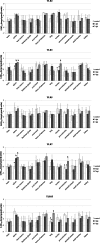Host Avian Beta-Defensin and Toll-Like Receptor Responses of Pigeons following Infection with Pigeon Paramyxovirus Type 1
- PMID: 26162868
- PMCID: PMC4542233
- DOI: 10.1128/AEM.01413-15
Host Avian Beta-Defensin and Toll-Like Receptor Responses of Pigeons following Infection with Pigeon Paramyxovirus Type 1
Abstract
The high morbidity and mortality in pigeons caused by pigeon paramyxovirus type 1 (PPMV-1) highlights the need for new insights into the host immune response and novel treatment approaches. Host defense peptides (HDPs) are key components of the innate immune system. In this study, three novel avian β-defensins (AvBDs 2, 7, and 10) were characterized in pigeons and shown to possess direct antiviral activity against PPMV-1 in vitro. In addition, we evaluated the mRNA expression of these AvBDs and other immune-related genes in tissues of 2-month-old infected pigeons at 3 and 7 days postinfection. We observed that the expression of AvBD2 in the cecal tonsil, lungs, and proventriculus, as well as the expression of AvBD10 in the spleen, lungs, proventriculus, and kidneys, was upregulated in infected pigeons. Similarly, the expression of both Toll-like receptor 3 (TLR3) and TLR7 was increased in the spleen, trachea, and proventriculus, while TLR15 expression was increased only in the lungs of infected pigeons. In addition, inducible nitric oxide synthase (iNOS) expression was upregulated in the spleen, the bursa of Fabricius, the trachea, and the proventriculus of infected pigeons. Furthermore, we observed a high correlation between the expression of AvBD2 and the expression of either TLR7 or TLR15, as well as between AvBD10 expression and either TLR3 or TLR7 expression in respective tissues. The results suggest that PPMV-1 infection can induce innate host responses characterized by the activation of TLRs, particularly TLR3 and TLR7, AvBDs (2 and 10), and iNOS in pigeons.
Copyright © 2015, American Society for Microbiology. All Rights Reserved.
Figures






Similar articles
-
Innate immune responses of domestic pigeons to the infection of pigeon paramyxovirus type 1 virus.Poult Sci. 2021 Feb;100(2):603-614. doi: 10.1016/j.psj.2020.11.045. Epub 2020 Nov 28. Poult Sci. 2021. PMID: 33518113 Free PMC article.
-
Host immune responses of pigeons infected with Newcastle disease viruses isolated from pigeons.Microb Pathog. 2019 Feb;127:131-137. doi: 10.1016/j.micpath.2018.11.049. Epub 2018 Nov 30. Microb Pathog. 2019. PMID: 30508624
-
Differential modulation of avian β-defensin and Toll-like receptor expression in chickens infected with infectious bronchitis virus.Appl Microbiol Biotechnol. 2015 Nov;99(21):9011-24. doi: 10.1007/s00253-015-6786-8. Epub 2015 Jul 4. Appl Microbiol Biotechnol. 2015. PMID: 26142390 Free PMC article.
-
Avian β-defensins expression for the innate immune system in hen reproductive organs.Poult Sci. 2015 Apr;94(4):804-9. doi: 10.3382/ps/peu021. Epub 2015 Feb 13. Poult Sci. 2015. PMID: 25681610 Review.
-
Occurrence, characteristics and control of pigeon paramyxovirus type 1 in pigeons.Pol J Vet Sci. 2014;17(2):379-84. doi: 10.2478/pjvs-2014-0056. Pol J Vet Sci. 2014. PMID: 24988870 Review.
Cited by
-
Infection of Goose with Genotype VIId Newcastle Disease Virus of Goose Origin Elicits Strong Immune Responses at Early Stage.Front Microbiol. 2016 Oct 4;7:1587. doi: 10.3389/fmicb.2016.01587. eCollection 2016. Front Microbiol. 2016. PMID: 27757109 Free PMC article.
-
Effect of Bifunctional β Defensin 2-Modified Scaffold on Bone Defect Reconstruction.ACS Omega. 2020 Feb 18;5(8):4302-4312. doi: 10.1021/acsomega.9b04249. eCollection 2020 Mar 3. ACS Omega. 2020. PMID: 32149260 Free PMC article.
-
Comparative analysis of early immune responses induced by two strains of Newcastle disease virus in chickens.Microbiologyopen. 2019 Apr;8(4):e00701. doi: 10.1002/mbo3.701. Epub 2018 Aug 1. Microbiologyopen. 2019. PMID: 30070070 Free PMC article.
-
Induction of Avian β-Defensin 2 Is Possibly Mediated by the p38 MAPK Signal Pathway in Chicken Embryo Fibroblasts After Newcastle Disease Virus Infection.Front Microbiol. 2018 Apr 19;9:751. doi: 10.3389/fmicb.2018.00751. eCollection 2018. Front Microbiol. 2018. PMID: 29725321 Free PMC article.
-
Innate immune responses of domestic pigeons to the infection of pigeon paramyxovirus type 1 virus.Poult Sci. 2021 Feb;100(2):603-614. doi: 10.1016/j.psj.2020.11.045. Epub 2020 Nov 28. Poult Sci. 2021. PMID: 33518113 Free PMC article.
References
-
- Dortmans JCFM, Rottier PJM, Koch G, Peeters BPH. 2011. Passaging of a Newcastle disease virus pigeon variant in chickens results in selection of viruses with mutations in the polymerase complex enhancing virus replication and virulence. J Gen Virol 92:336–345. doi:10.1099/vir.0.026344-0. - DOI - PubMed
-
- Alexander DJ. 2003. Newcastle disease, p 64–87. In Saif YM, Barnes HJ, Glisson JR, Fadly AM, McDougald LR, Swayne DE (ed), Diseases of poultry, 11th ed Iowa State University Press, Ames, IA.
Publication types
MeSH terms
Substances
LinkOut - more resources
Full Text Sources

